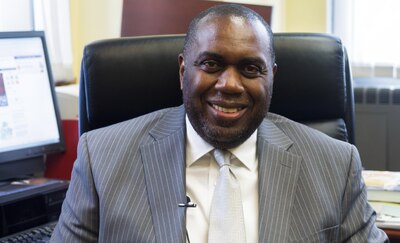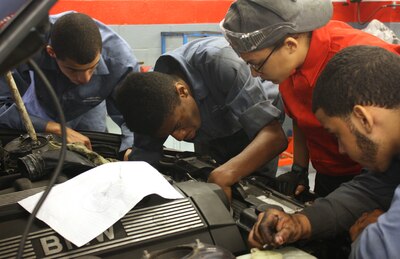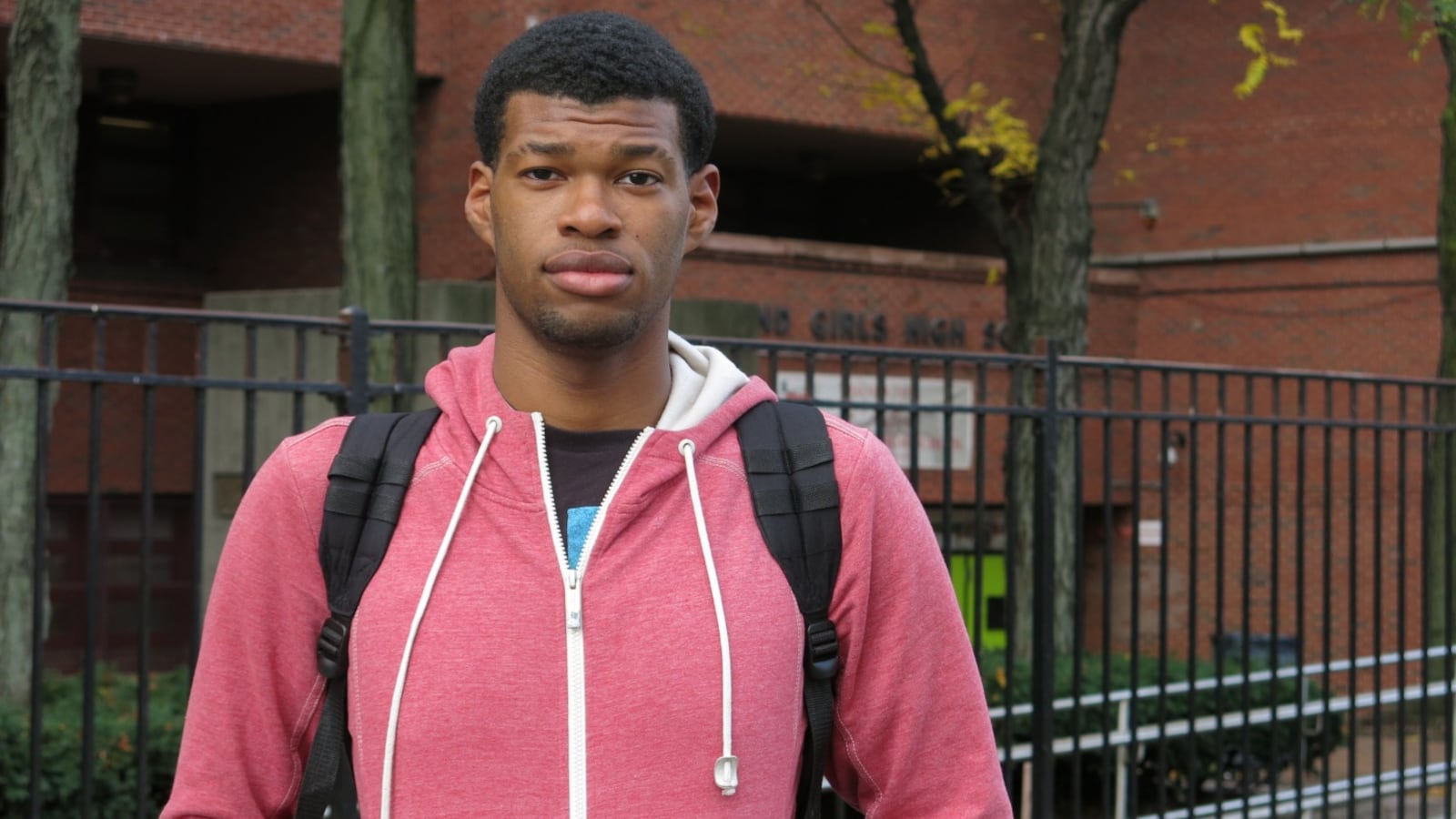Calvin Brown, Jr. enrolled at Boys and Girls High School midway through his sophomore year after falling behind at a nearby charter school. Though the Bedford-Stuyvesant high school is considered one of the city’s worst, Brown thrived there.
He became the junior class president last year and the captain of the debate team, which is set to travel to South Africa next month for a competition. He had entered the school with just seven credits, but as he started his senior year this September he had three times that amount — still half as many as he needs to graduate, but he was catching up.
Then, after the school’s outspoken principal resigned last month, the city installed a new leader to turn around the troubled school. Under new principal Michael Wiltshire, students who are missing many credits or otherwise unlikely to graduate this year have been encouraged to transfer out, according to Brown and staffers at the school. Brown was one of the students urged to leave.
“They made me transfer,” said Brown, 17. “They don’t want me on the Boys and Girls roster.”
Leaders ordered to overhaul struggling high schools like Boys and Girls have limited options. They may try to retrain teachers or add tutoring time, but city regulations and the teachers union contract can stop them from taking more drastic steps. But one significant change they can make is to quietly adjust the school’s student population by advising underachieving students to transfer out.
Principals who have done that argue it is in the students’ best interest, since the alternative high schools where they land are designed to help students who are chronically absent and missing credits to graduate. But struggling high schools under intense pressure to improve also benefit by nudging out those students, since the schools are judged partly by their graduation rates.
Whether principals should treat student transfers as a turnaround strategy may come up for debate as the leaders of more than 90 low-performing schools try to make improvements under a new city program launched this week. The program gives schools extra support, but does not allow for immediate staffing changes or restructuring.
People at Boys and Girls High School say that about 30 students have transferred out since Wiltshire took over three weeks ago. Many of the students moved to Research and Service High School, an alternative school in the same building, according to an employee there.
“Since the administration change took place,” the employee said, “it seems like there’s some sort of mass exodus going on.”

One of Wiltshire’s first moves was to summon to the auditorium all the older students who were behind academically and let them know their odds of graduating could improve if they switched schools, according to Brown and other sources at Boys and Girls. He also said that students would now be expected to earn diplomas in four years, otherwise the school would help them find new placements, Brown said. (Last year, just 44 percent of Boys and Girls students hit the four-year graduation target.)
After the talk, a guidance counselor asked to meet with Brown and his father last week. In the past, Brown and the counselor had discussed ways he could make up his missing credits and still graduate from Boys and Girls, Brown said. But at this meeting, the counselor said Brown had too few credits and should transfer to an alternative school, Brown said. Convinced that he had to leave, Brown and his father reluctantly agreed to the move.
“Why don’t you take the kids who have problems and deal with them instead of pushing them out?” said Mary Saxon, Brown’s grandmother, who also spoke with the counselor. She said she told the counselor that her grandson wanted to remain at Boys and Girls, but the counselor said, “He has to go.”
A staffer said the school had occasionally advised off-track students to switch schools in the past, but never this “aggressively.” Because of Boys and Girls’ chronic low performance, the state has designated it as “out of time” and ordered it to show signs of improvement this year. Removing students who are far behind in school appears to be part of Wiltshire’s plan to produce a higher graduation rate, according to the staffer and Caster Hall, the school’s parent association president.
“The new principal is trying to kick out all the students who don’t have enough credits to get his graduation rate up,” said Hall, who is the brother of the principal who resigned. “It’s all about the numbers.”
Wiltshire did not respond to emails or phone messages, and school guidance counselors referred questions to the education department.
Department spokeswoman Devora Kaye would not comment on the situation at Boys and Girls. But she said that students should be in schools that best meet their needs, which can include transfer schools, the small alternative high schools designed for dropouts and students struggling to graduate.
“The DOE would never tolerate a student being forced out of any school,” she added.
The matter is especially delicate at Boys and Girls, which was the subject of a class action lawsuit a decade ago alleging that the school warehoused troublesome students in the auditorium as a way to push them out.
Brown’s claim — that he was pressured to transfer to another school— differs from the 2005 lawsuit, which alleged that the school’s actions drove students to drop out of school completely, said Rebecca Shore, director of litigation at Advocates for Children, the nonprofit that helped file the lawsuit. (As part of a 2008 settlement, the city agreed to put Boys and Girls under the oversight of a monitor for several years and make sure the school got approval before transferring students.)
Still, Brown’s situation highlights a common problem, Shore said. Students have the right to remain in school until the end of the year they turn 21, and administrators must follow strict protocols to make students switch schools against their will. But administrators sometimes work around those rules by convincing students that they will not graduate from their current school, and so should transfer to an alternative school, Shore said.
“It comes off in theory as the student wanting this and consenting,” she said. “But really, it’s more of the school pushing the student out.”

If Wiltshire’s plan to improve Boys and Girls involves convincing some challenging students to transfer out, he would not be the first turnaround principal to try that approach.
Evan Schwartz was sent to Alfred E. Smith Career and Technical Education High School in the Bronx two years ago with orders from the city to make drastic changes. One of his first actions was to encourage older students who regularly skipped class and were far behind in credits to switch schools.
“I moved 100 kids in my first four months,” he said.
Schwartz notes that the city created alternative schools to serve so-called overage, under-credited students like the ones who left his school. Transfer schools, for example, tend to have smaller classes, extra social workers, and accelerated programs that let such students earn credits quickly in order to graduate. Other programs offer evening classes and paid internships.
Schwartz emphasized that he never forced lagging students to leave. Rather, he explained to the students that other schools were designed to help them catch up but, if they decided to stay at Smith, they could no longer cut class and ignore the rules.
Still, Schwartz said that it was crucial to get those students into a different school if he was going to improve Smith. Many of them were 19 years old, far behind academically, and only interested in wandering the halls and lunchroom, he said.
“You don’t want kids like that in the school,” Schwartz said. “It makes it hard to change the culture.”

